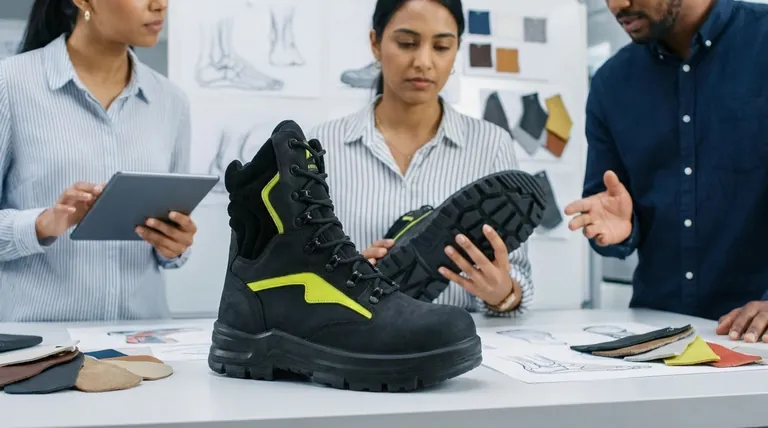One of the most persistent myths in boot fitting is the idea that new boots must feel uncomfortably tight at first to allow for a "break-in" period. The reality is that while a boot's inner materials will conform to your foot, the fundamental fit should be secure and comfortable right out of the box. A boot that causes initial pain is almost always the wrong boot.
The core principle of a modern boot fit is achieving security, not enduring pain. The "break-in" process involves the boot's padding molding to your foot's unique shape, not the boot's structure stretching to a larger size.

The Myth of the "Painful Break-in"
The advice to "suffer through the break-in" is outdated, yet it remains surprisingly common. Understanding its origin helps clarify why it no longer applies to most modern footwear.
Where This Idea Comes From
This concept originates from the era of traditional, all-leather boots. Heavy, stiff leather was the primary material, and it genuinely needed considerable time and wear to soften, stretch, and mold to the wearer's foot.
Why Modern Boots Are Different
Today, most boots are constructed with advanced synthetic materials, engineered meshes, and heat-moldable foam liners. These materials are designed for an anatomical fit from the start.
While the foam and padding will compress slightly and conform to your foot's contours, the boot's shell or primary structure will not stretch significantly.
What a Correct Boot Fit Actually Feels Like
Instead of focusing on a future, "broken-in" state, you must evaluate the fit as it is in the store. The goal is to eliminate movement without creating painful pressure points.
The Goal: Secure, Not Squeezed
A correctly fitted boot should feel like a firm, consistent handshake around your foot. Your foot should feel locked in place, especially at the heel and midfoot, but your toes should not be crammed or curled.
Key Fit Checkpoints
When trying on boots, pay close attention to three areas. Your heel should remain planted with minimal to no lift when you walk. You should have just enough room to wiggle your toes at the front. Finally, the boot's width should feel snug and supportive without pinching the sides of your foot.
Distinguishing Snug from Painful
Snugness is uniform, even pressure that holds your foot securely. Pain is a sharp, focused pressure on a specific spot, such as the side of your big toe, the top of your instep, or your ankle bone. Numbness or tingling are immediate red flags that the fit is too tight.
Understanding the Trade-offs of a Bad Fit
Choosing the wrong size—either too large or too small—creates distinct problems that compromise both comfort and performance.
The Danger of "Too Tight"
A boot that is too restrictive can cause blisters, bunions, nerve pain, and poor blood circulation. This not only leads to immediate discomfort but can also cause long-term foot health issues.
The Problem with "Too Loose"
Conversely, a boot that is too big allows your foot to slide internally. This friction is a primary cause of blisters. It also reduces your control and stability, increasing the risk of twisted ankles or falls, especially on uneven terrain.
How to Ensure the Right Fit From Day One
To avoid guesswork, prioritize how the boot feels in the moment and match the fit to your primary activity.
- If your primary focus is performance (e.g., technical hiking, skiing): Prioritize a snug, secure fit with zero heel lift to maximize control, but never accept sharp pain points.
- If your primary focus is all-day comfort (e.g., casual wear, light walking): A comfortable fit right out of the box is non-negotiable; there should be ample room for your toes to splay naturally.
- If you are buying traditional leather boots: Expect a very snug initial fit that will mold over time, but it must still be wearable without causing immediate, sharp pain or cutting off circulation.
Ultimately, you should trust what your feet are telling you right now, not what you hope the boot might feel like weeks from now.
Summary Table:
| Misconception | Reality |
|---|---|
| Boots must feel uncomfortably tight to break in. | A correct fit should be secure and comfortable immediately. |
| The boot's structure will stretch significantly. | Modern materials mold to your foot; the shell does not stretch. |
| Initial pain is a normal part of the process. | Pain is a red flag indicating the wrong size or fit. |
| The goal is to endure until the boot softens. | The goal is to achieve a secure, locked-in feel from day one. |
Stop guessing and start with the perfect fit. As a large-scale manufacturer, 3515 produces a comprehensive range of footwear for distributors, brand owners, and bulk clients. Our production capabilities encompass all types of shoes and boots, engineered for superior comfort and performance from the first wear. Let us help you provide your customers with boots that feel right immediately.
Contact our experts today to discuss your manufacturing needs.
Visual Guide

Related Products
- Premium Waterproof Nubuck Safety Boots for Wholesale
- Premium Grain Leather Safety Boots for Bulk Supply
- Wholesale Slip-On Safety Boots Manufacturer - Custom Puncture-Proof & Steel Toe
- Wholesale Safety Footwear Manufacturer for Bulk & Custom OEM Orders
- Heavy-Duty Waterproof Nubuck Safety Boots Safety Shoes for Bulk Supply
People Also Ask
- What other types of protective workwear are commonly used on worksites? Essential PPE for Complete Safety
- When should a safety toe be replaced? A Guide to Proactive Footwear Safety
- What additional safety equipment might be needed with work boots? Complete Your PPE System for Total Protection
- How do safety features in work boots contribute to overall comfort and safety? Unlock the Secret to All-Day Protection
- What standards must safety toe boots meet? Ensure Your Footwear Meets ASTM F2413



















